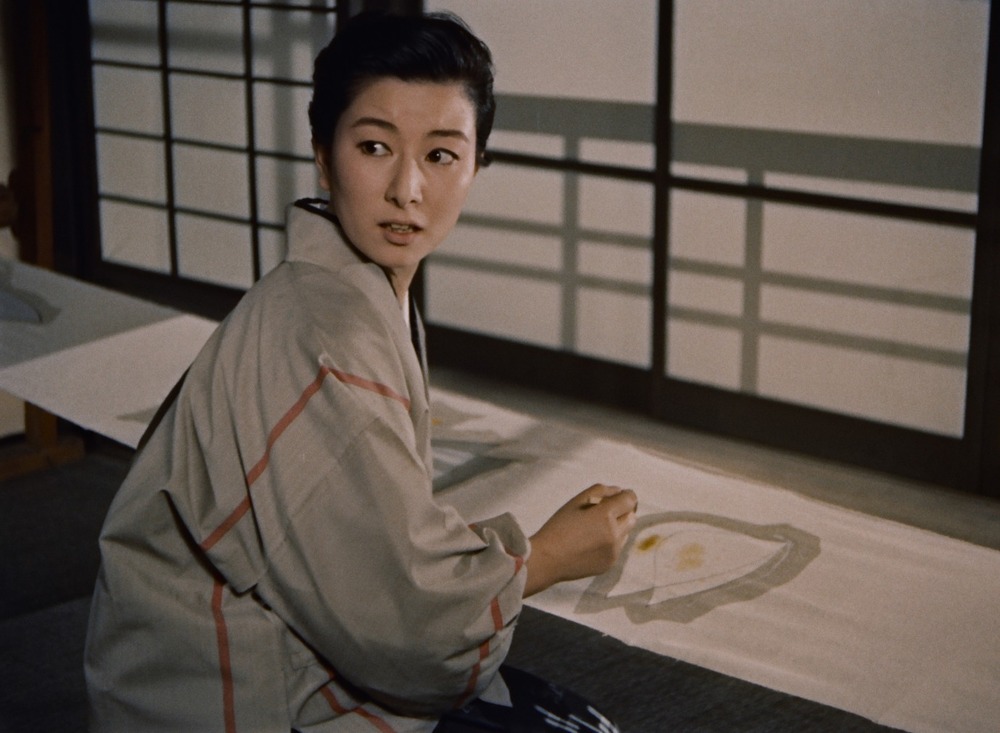Kozaburo Yoshimura’s recently restored Undercurrent (1956) thematizes the tension between tradition and modernity, a tug-of-war that is also evident on a formal level. It is an almost treacly melodrama, with characters sporadically bursting into song, but the film is also lent a decidedly more unsettling ambiance by Sei Ikeno’s dissonant score. In a film narratively governed by an only mildly taboo-defying story of a successful businesswoman who falls for a married man, spice is added by Ikeno’s incongruously menacing chords. Ikeno had studied under and assisted Akira Ifukube, the composer on Ishiro Honda’s Godzilla (1954) and developer of the kaiju’s iconic roar. Although the dominant mood in Undercurrent is the ebullience of the Japanese economic miracle, Ikeno’s score tinges it with a foreboding that continuously recalls the lingering trauma of the war.
Kadokawa’s new digital restoration of Yoshimura’s first color film is gorgeous, doing justice to frequent Ozu and Kurosawa collaborator Kazuo Miyagawa’s elegant camerawork. His craft peaks when enterprising fabric-dyer Kiwa (Fujiko Yamamoto) and taciturn geneticist Takemura (Ken Uehara) have a chance tryst in Miyoshi Inn, taking cover from a downpour under dripping eaves in the light of the inn’s single globe lamp, and, moments later, half-whispering and smoking cigarettes on tatamis, awash in a subdued sienna light. Miyagawa’s lens lingers on the contours of the characters’ faces and bodies, adding a surprising sensuality to an otherwise restrained visual vocabulary.
Film scholar Alexander Jacoby has written about Undercurrent as part of a sequence of films that Yoshimura made between 1951 and 1960 about women working in traditional industries in Kyoto. Although in the postwar period “the percentage of workers of both sexes employed by family businesses declined by roughly half,” Jacoby writes, Kyoto “remained a center of small-scale cottage industries.” The traditional business that Kiwa is engaged in is fabric dyeing, specializing in hand-drawn Yuzen silks and wax-resist textiles. She’s dogged in her pursuit of clients and retailers, often told that she has surpassed her father as a salesman. Her commercial endeavors serve as occasions for the film’s many debates around gender roles. “I try not to capitalize on my femininity,” she says and picks up the tab on a first date, girlbossing her way through postwar Japan’s changing economic and social landscape. Her friends and relatives are concerned about her independence, seeing it as both a strength and a liability. Her father gets unsolicited advice from a colleague’s wife that reimposes the cultural force that traditional roles continue to exert: “She may be strong-willed, but she’s a woman after all.”
Labor is obviously a strong theme in Undercurrent, chiefly through its preoccupation with Kiwa’s career, but also through secondary characters. Toshio, a young trainee at Kiwa’s workshop, is introduced bitching about the backwardness of the business: “‘Master’ and ‘apprentice’ are obsolete concepts . . . There’s no future in such an out-of-date line of work.” His dissatisfaction takes on a political dimension, as when he complains about the constant overtime: “The Labor Standards Act is stated in the Constitution!” (The Labor Standards Act of 1947 was an important piece of legislation in defining postwar Japan’s economy, regulating working hours, paid leave, and accident compensation and prohibiting wage discrimination based on sex.) Significantly, the film is also bookended by May Day parades that fill the streets of Kyoto, young workers waving red flags and singing proletarian anthems. Tosho may only have a few lines, but he represents an emerging voice in the Japanese labor market: industrial workers aware of their class position and ready to collectively demand conditions more in line with human dignity.
Undercurrent screens tonight and tomorrow, January 24 and 25, at the Museum of Modern Art as part of “To Save and Project: The 20th MoMA International Festival of Film Preservation.”


